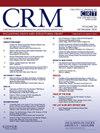C反应蛋白水平升高对经导管主动脉瓣置换术患者长期预后的影响。
IF 1.6
Q3 CARDIAC & CARDIOVASCULAR SYSTEMS
引用次数: 0
摘要
背景:在接受经导管主动脉瓣置换术(TAVR)的患者中,经常观察到术前 C 反应蛋白(CRP)水平升高。其对 TAVR 长期效果的影响尚不明确。该研究旨在调查TAVR术前CRP水平正常与升高的TAVR患者的长期(长达6年)临床结果:研究纳入了 2012 年 8 月至 2023 年 1 月期间在一家三级心脏病医院接受 TAVR 的连续患者。根据基线 CRP 水平将患者分为两组:正常 CRP(≤ 5 毫克/升)和升高 CRP(>5 毫克/升)。在TAVR术后对这两组患者进行了长达6年的临床随访:结果:在总共 1000 名 TAVR 患者(平均年龄 81 ± 6 岁)中,发现 268 名患者(27%)基线 CRP 升高(>5 毫克/升)。这些患者的合并疾病(如慢性阻塞性肺病、心房颤动、心力衰竭、并发瓣膜病)明显增多。他们还更常发生围手术期感染(3% 对 1%,P = 0.007),并在随访期间更常因感染而重复住院(HR 1.97,CI 1.47-2.64,P 结论:尽管 TAV 手术的长期结果并不理想,但这并不意味着 TAV 手术的失败:尽管术前 CRP 水平升高的 TAVR 患者在存活率和瓣膜功能障碍发展方面的长期结果似乎良好,但他们在随访期间发生围术期感染和因任何类型的感染而再次入院的风险增加。本文章由计算机程序翻译,如有差异,请以英文原文为准。
The impact of elevated C-reactive protein levels on long-term outcomes of patients undergoing transcatheter aortic valve replacement
Background
In patients undergoing transcatheter aortic valve replacement (TAVR), elevated pre-procedural C-reactive protein (CRP) levels are frequently observed. Its impact on long-term results of TAVR is unclear. The aim of the study was to investigate the long-term (up to six years) clinical outcomes of TAVR patients with normal compared to elevated CRP levels before TAVR.
Methods
Consecutive patients undergoing TAVR between August 2012 and January 2023 at a tertiary cardiology facility were included. Patients were divided into two cohorts based on the baseline CRP levels: normal CRP (≤ 5 mg/l) and elevated CRP (>5 mg/l). The cohorts were followed clinically for up to six years after TAVR.
Results
From a total of 1000 TAVR patients (mean age 81 ± 6 years), 268 patients (27 %) were found to have elevated baseline CRP (>5 mg/l). Such patients had significantly more co-morbidities (e.g. chronic obstructive pulmonary disease, atrial fibrillation, heart failure, concomitant valvopathies). They also developed periprocedural infections more frequently (3 % vs. 1 %, p = 0.007) and required more commonly repeat hospitalizations for infections during follow-up (HR 1.97, CI 1.47–2.64, p < 0.001). All-cause mortality and development of valve dysfunction did not significantly differ between patients with elevated and normal baseline CRP levels.
Conclusion
Albeit long-term results of TAVR patients with elevated pre-procedural CRP levels seem favorable in terms of survival and development of valve dysfunction, they have an increased risk for periprocedural infections and re-admissions due to infections of any type during the follow-up period.
求助全文
通过发布文献求助,成功后即可免费获取论文全文。
去求助
来源期刊

Cardiovascular Revascularization Medicine
CARDIAC & CARDIOVASCULAR SYSTEMS-
CiteScore
3.30
自引率
5.90%
发文量
687
审稿时长
36 days
期刊介绍:
Cardiovascular Revascularization Medicine (CRM) is an international and multidisciplinary journal that publishes original laboratory and clinical investigations related to revascularization therapies in cardiovascular medicine. Cardiovascular Revascularization Medicine publishes articles related to preclinical work and molecular interventions, including angiogenesis, cell therapy, pharmacological interventions, restenosis management, and prevention, including experiments conducted in human subjects, in laboratory animals, and in vitro. Specific areas of interest include percutaneous angioplasty in coronary and peripheral arteries, intervention in structural heart disease, cardiovascular surgery, etc.
 求助内容:
求助内容: 应助结果提醒方式:
应助结果提醒方式:


